fuel cap SAAB 9-5 2009 Owners Manual
[x] Cancel search | Manufacturer: SAAB, Model Year: 2009, Model line: 9-5, Model: SAAB 9-5 2009Pages: 272, PDF Size: 21.53 MB
Page 59 of 272
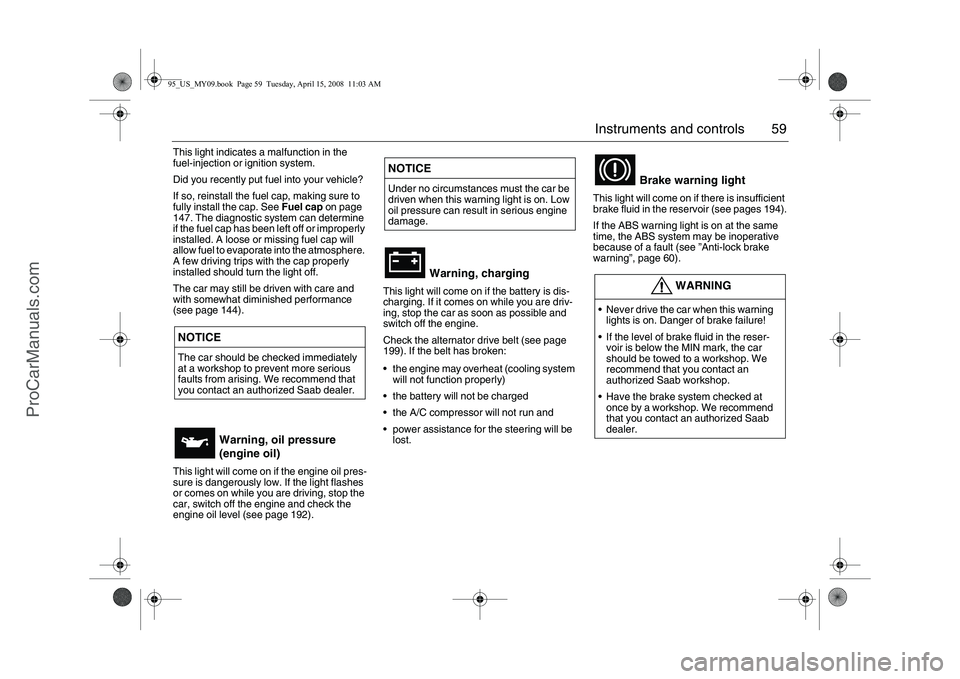
59 Instruments and controls
This light indicates a malfunction in the
fuel-injection or ignition system.
Did you recently put fuel into your vehicle?
If so, reinstall the fuel cap, making sure to
fully install the cap. See Fuel cap on page
147. The diagnostic system can determine
if the fuel cap has been left off or improperly
installed. A loose or missing fuel cap will
allow fuel to evaporate into the atmosphere.
A few driving trips with the cap properly
installed should turn the light off.
The car may still be driven with care and
with somewhat diminished performance
(see page 144).
This light will come on if the engine oil pres-
sure is dangerously low. If the light flashes
or comes on while you are driving, stop the
car, switch off the engine and check the
engine oil level (see page 192).
This light will come on if the battery is dis-
charging. If it comes on while you are driv-
ing, stop the car as soon as possible and
switch off the engine.
Check the alternator drive belt (see page
199). If the belt has broken:
the engine may overheat (cooling system
will not function properly)
the battery will not be charged
the A/C compressor will not run and
power assistance for the steering will be
lost.This light will come on if there is insufficient
brake fluid in the reservoir (see pages 194).
If the ABS warning light is on at the same
time, the ABS system may be inoperative
because of a fault (see ”Anti-lock brake
warning”, page 60).
NOTICEThe car should be checked immediately
at a workshop to prevent more serious
faults from arising. We recommend that
you contact an authorized Saab dealer.
Warning, oil pressure
(engine oil)
NOTICEUnder no circumstances must the car be
driven when this warning light is on. Low
oil pressure can result in serious engine
damage.
Warning, charging
Brake warning light
WARNING
Never drive the car when this warning
lights is on. Danger of brake failure!
If the level of brake fluid in the reser-
voir is below the MIN mark, the car
should be towed to a workshop. We
recommend that you contact an
authorized Saab workshop.
Have the brake system checked at
once by a workshop. We recommend
that you contact an authorized Saab
dealer.
95_US_MY09.book Page 59 Tuesday, April 15, 2008 11:03 AM
ProCarManuals.com
Page 65 of 272
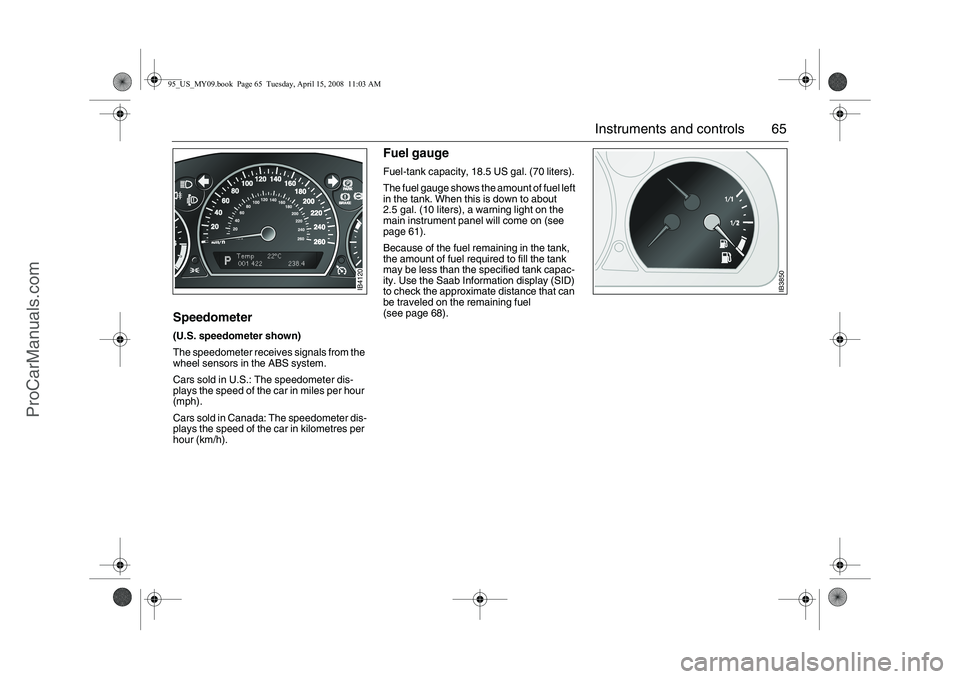
65 Instruments and controls
Speedometer(U.S. speedometer shown)
The speedometer receives signals from the
wheel sensors in the ABS system.
Cars sold in U.S.: The speedometer dis-
plays the speed of the car in miles per hour
(mph).
Cars sold in Canada: The speedometer dis-
plays the speed of the car in kilometres per
hour (km/h).
Fuel gauge Fuel-tank capacity, 18.5 US gal. (70 liters).
The fuel gauge shows the amount of fuel left
in the tank. When this is down to about
2.5 gal. (10 liters), a warning light on the
main instrument panel will come on (see
page 61).
Because of the fuel remaining in the tank,
the amount of fuel required to fill the tank
may be less than the specified tank capac-
ity. Use the Saab Information display (SID)
to check the approximate distance that can
be traveled on the remaining fuel
(see page 68).
IB4120
IB3850
95_US_MY09.book Page 65 Tuesday, April 15, 2008 11:03 AM
ProCarManuals.com
Page 143 of 272
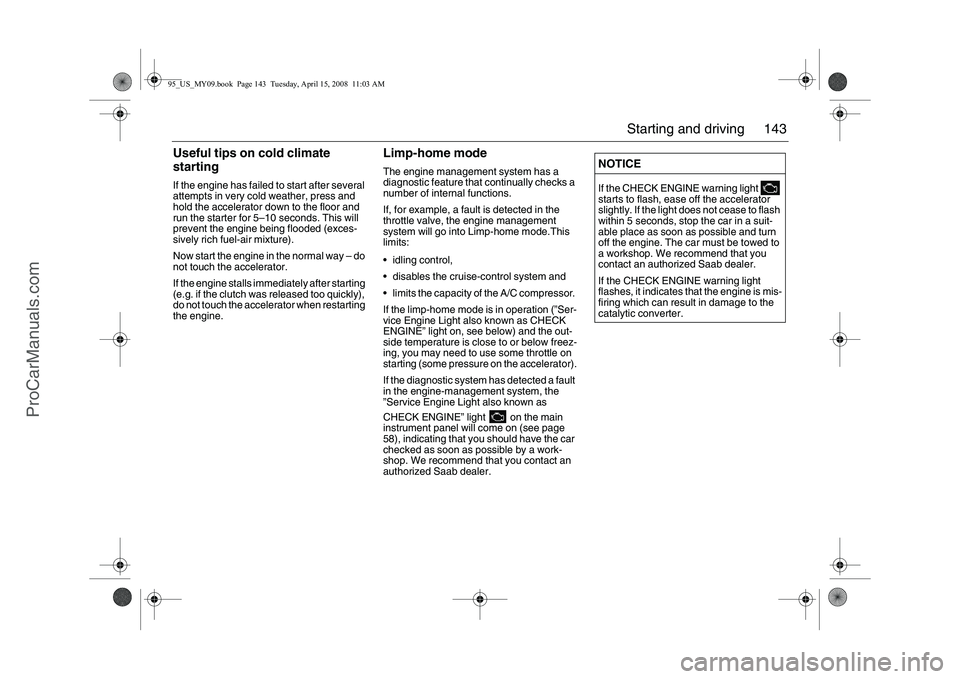
143 Starting and driving
Useful tips on cold climate
startingIf the engine has failed to start after several
attempts in very cold weather, press and
hold the accelerator down to the floor and
run the starter for 5–10 seconds. This will
prevent the engine being flooded (exces-
sively rich fuel-air mixture).
Now start the engine in the normal way – do
not touch the accelerator.
If the engine stalls immediately after starting
(e.g. if the clutch was released too quickly),
do not touch the accelerator when restarting
the engine.
Limp-home modeThe engine management system has a
diagnostic feature that continually checks a
number of internal functions.
If, for example, a fault is detected in the
throttle valve, the engine management
system will go into Limp-home mode.This
limits:
idling control,
disables the cruise-control system and
limits the capacity of the A/C compressor.
If the limp-home mode is in operation (”Ser-
vice Engine Light also known as CHECK
ENGINE” light on, see below) and the out-
side temperature is close to or below freez-
ing, you may need to use some throttle on
starting (some pressure on the accelerator).
If the diagnostic system has detected a fault
in the engine-management system, the
”Service Engine Light also known as
CHECK ENGINE” light on the main
instrument panel will come on (see page
58), indicating that you should have the car
checked as soon as possible by a work-
shop. We recommend that you contact an
authorized Saab dealer.
NOTICEIf the CHECK ENGINE warning light
starts to flash, ease off the accelerator
slightly. If the light does not cease to flash
within 5 seconds, stop the car in a suit-
able place as soon as possible and turn
off the engine. The car must be towed to
a workshop. We recommend that you
contact an authorized Saab dealer.
If the CHECK ENGINE warning light
flashes, it indicates that the engine is mis-
firing which can result in damage to the
catalytic converter.
95_US_MY09.book Page 143 Tuesday, April 15, 2008 11:03 AM
ProCarManuals.com
Page 146 of 272
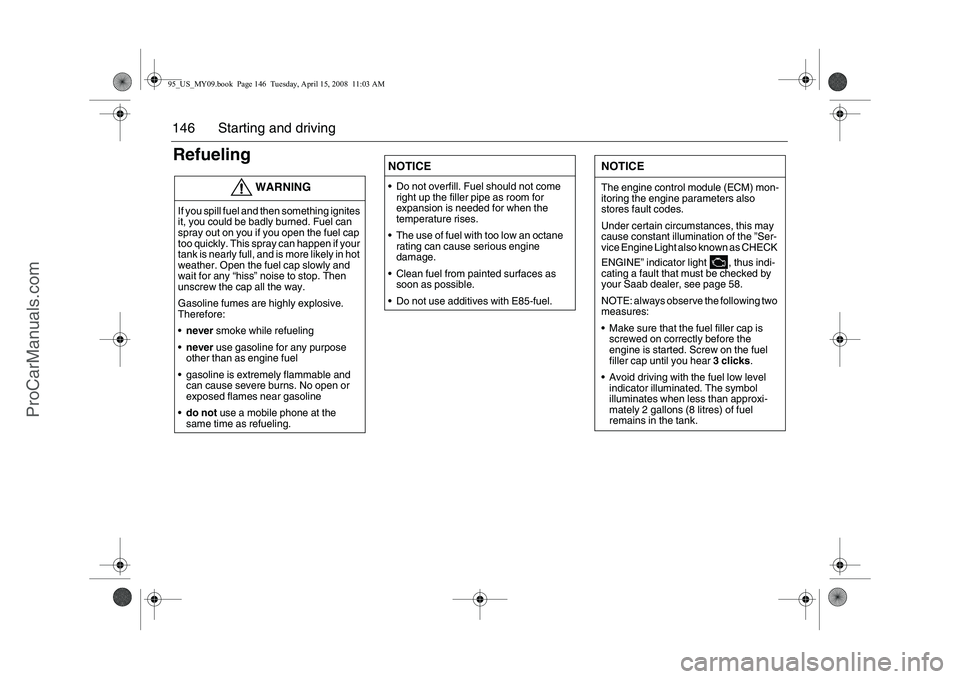
146 Starting and drivingRefueling
WARNING
If you spill fuel and then something ignites
it, you could be badly burned. Fuel can
spray out on you if you open the fuel cap
too quickly. This spray can happen if your
tank is nearly full, and is more likely in hot
weather. Open the fuel cap slowly and
wait for any “hiss” noise to stop. Then
unscrew the cap all the way.
Gasoline fumes are highly explosive.
Therefore:
never smoke while refueling
never use gasoline for any purpose
other than as engine fuel
gasoline is extremely flammable and
can cause severe burns. No open or
exposed flames near gasoline
do not use a mobile phone at the
same time as refueling.
NOTICE Do not overfill. Fuel should not come
right up the filler pipe as room for
expansion is needed for when the
temperature rises.
The use of fuel with too low an octane
rating can cause serious engine
damage.
Clean fuel from painted surfaces as
soon as possible.
Do not use additives with E85-fuel.
NOTICEThe engine control module (ECM) mon-
itoring the engine parameters also
stores fault codes.
Under certain circumstances, this may
cause constant illumination of the ”Ser-
vice Engine Light also known as CHECK
ENGINE” indicator light , thus indi-
cating a fault that must be checked by
your Saab dealer, see page 58.
NOTE: always observe the following two
measures:
Make sure that the fuel filler cap is
screwed on correctly before the
engine is started. Screw on the fuel
filler cap until you hear 3 clicks.
Avoid driving with the fuel low level
indicator illuminated. The symbol
illuminates when less than approxi-
mately 2 gallons (8 litres) of fuel
remains in the tank.
95_US_MY09.book Page 146 Tuesday, April 15, 2008 11:03 AM
ProCarManuals.com
Page 147 of 272
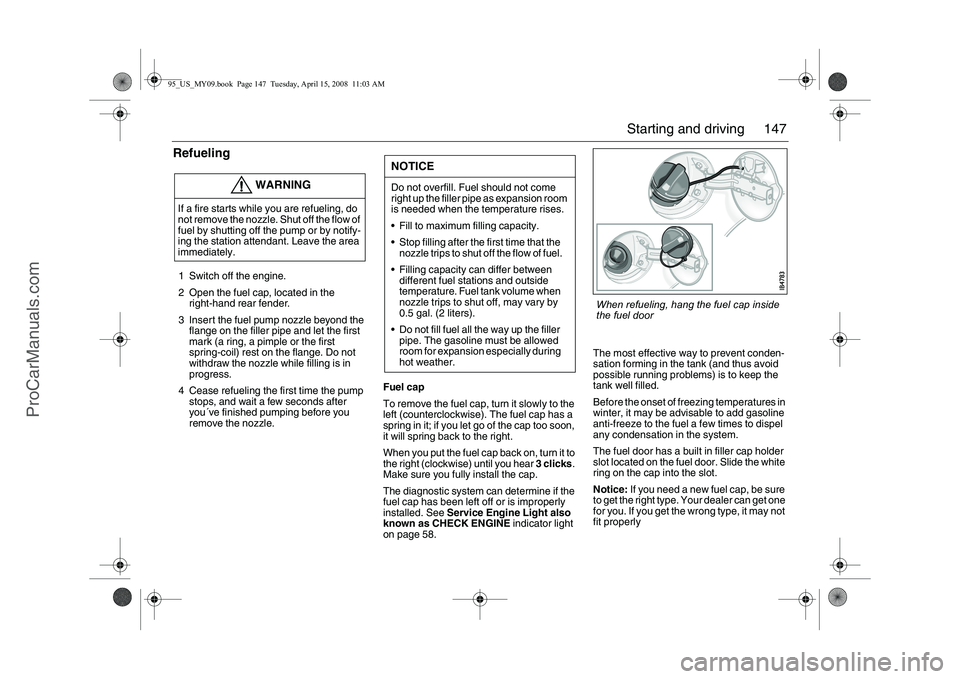
147 Starting and driving
Refueling1 Switch off the engine.
2 Open the fuel cap, located in the
right-hand rear fender.
3 Insert the fuel pump nozzle beyond the
flange on the filler pipe and let the first
mark (a ring, a pimple or the first
spring-coil) rest on the flange. Do not
withdraw the nozzle while filling is in
progress.
4 Cease refueling the first time the pump
stops, and wait a few seconds after
you´ve finished pumping before you
remove the nozzle.Fuel cap
To remove the fuel cap, turn it slowly to the
left (counterclockwise). The fuel cap has a
spring in it; if you let go of the cap too soon,
it will spring back to the right.
When you put the fuel cap back on, turn it to
the right (clockwise) until you hear 3 clicks.
Make sure you fully install the cap.
The diagnostic system can determine if the
fuel cap has been left off or is improperly
installed. See Service Engine Light also
known as CHECK ENGINE indicator light
on page 58.The most effective way to prevent conden-
sation forming in the tank (and thus avoid
possible running problems) is to keep the
tank well filled.
Before the onset of freezing temperatures in
winter, it may be advisable to add gasoline
anti-freeze to the fuel a few times to dispel
any condensation in the system.
The fuel door has a built in filler cap holder
slot located on the fuel door. Slide the white
ring on the cap into the slot.
Notice: If you need a new fuel cap, be sure
to get the right type. Your dealer can get one
for you. If you get the wrong type, it may not
fit properly
WARNING
If a fire starts while you are refueling, do
not remove the nozzle. Shut off the flow of
fuel by shutting off the pump or by notify-
ing the station attendant. Leave the area
immediately.
NOTICEDo not overfill. Fuel should not come
right up the filler pipe as expansion room
is needed when the temperature rises.
Fill to maximum filling capacity.
Stop filling after the first time that the
nozzle trips to shut off the flow of fuel.
Filling capacity can differ between
different fuel stations and outside
temperature. Fuel tank volume when
nozzle trips to shut off, may vary by
0.5 gal. (2 liters).
Do not fill fuel all the way up the filler
pipe. The gasoline must be allowed
room for expansion especially during
hot weather.
When refueling, hang the fuel cap inside
the fuel door
95_US_MY09.book Page 147 Tuesday, April 15, 2008 11:03 AM
ProCarManuals.com
Page 191 of 272
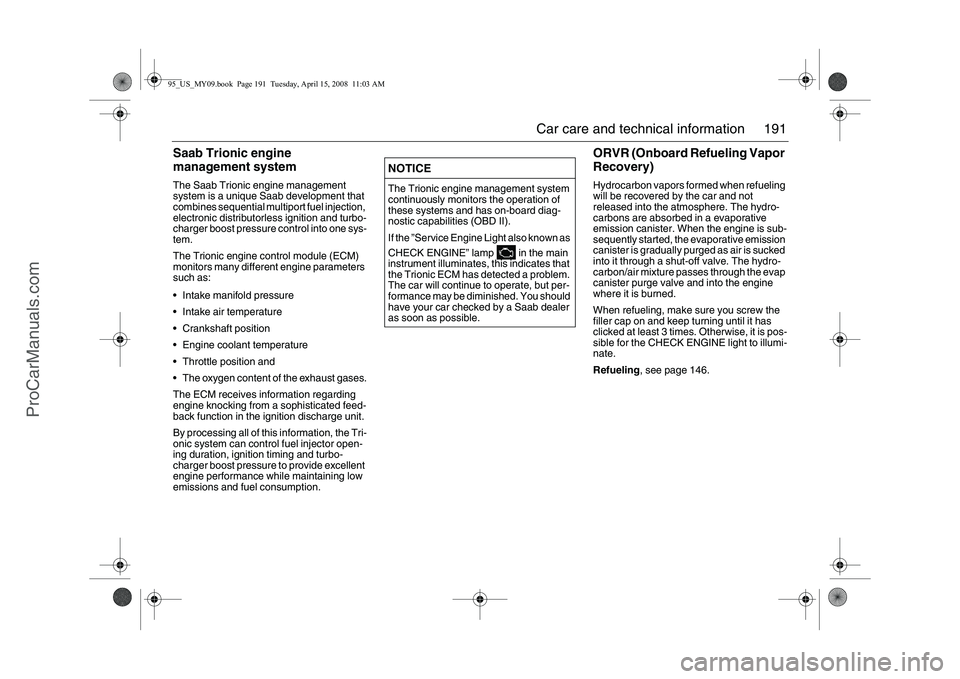
191 Car care and technical information
Saab Trionic engine
management systemThe Saab Trionic engine management
system is a unique Saab development that
combines sequential multiport fuel injection,
electronic distributorless ignition and turbo-
charger boost pressure control into one sys-
tem.
The Trionic engine control module (ECM)
monitors many different engine parameters
such as:
Intake manifold pressure
Intake air temperature
Crankshaft position
Engine coolant temperature
Throttle position and
The oxygen content of the exhaust gases.
The ECM receives information regarding
engine knocking from a sophisticated feed-
back function in the ignition discharge unit.
By processing all of this information, the Tri-
onic system can control fuel injector open-
ing duration, ignition timing and turbo-
charger boost pressure to provide excellent
engine performance while maintaining low
emissions and fuel consumption.
ORVR (Onboard Refueling Vapor
Recovery)Hydrocarbon vapors formed when refueling
will be recovered by the car and not
released into the atmosphere. The hydro-
carbons are absorbed in a evaporative
emission canister. When the engine is sub-
sequently started, the evaporative emission
canister is gradually purged as air is sucked
into it through a shut-off valve. The hydro-
carbon/air mixture passes through the evap
canister purge valve and into the engine
where it is burned.
When refueling, make sure you screw the
filler cap on and keep turning until it has
clicked at least 3 times. Otherwise, it is pos-
sible for the CHECK ENGINE light to illumi-
nate.
Refueling, see page 146.
NOTICEThe Trionic engine management system
continuously monitors the operation of
these systems and has on-board diag-
nostic capabilities (OBD II).
If the ”Service Engine Light also known as
CHECK ENGINE” lamp in the main
instrument illuminates, this indicates that
the Trionic ECM has detected a problem.
The car will continue to operate, but per-
formance may be diminished. You should
have your car checked by a Saab dealer
as soon as possible.
95_US_MY09.book Page 191 Tuesday, April 15, 2008 11:03 AM
ProCarManuals.com
Page 229 of 272
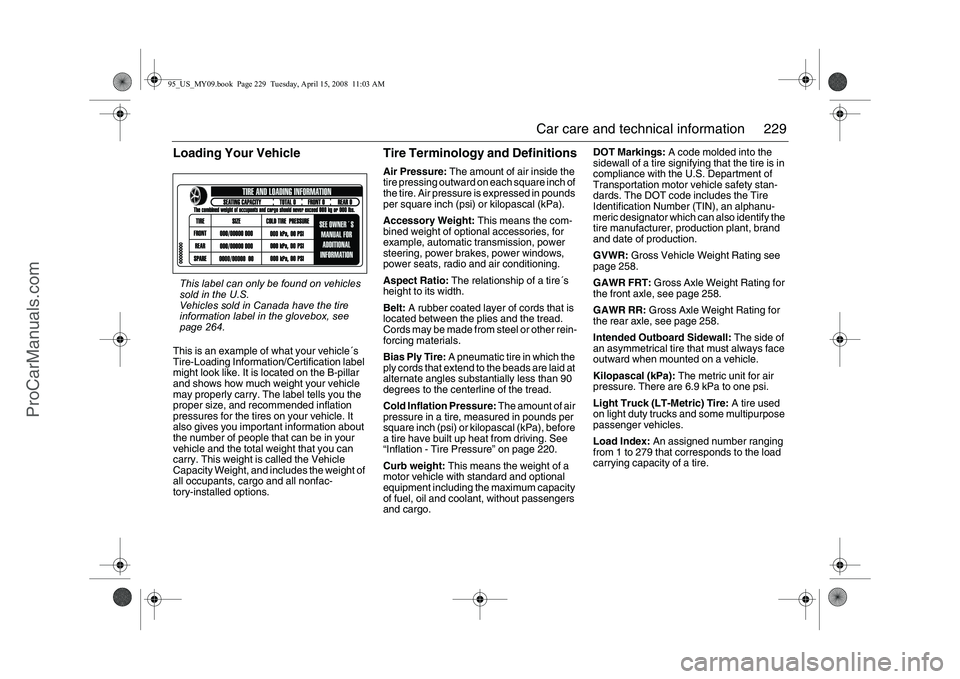
229 Car care and technical information
Loading Your VehicleThis is an example of what your vehicle´s
Tire-Loading Information/Certification label
might look like. It is located on the B-pillar
and shows how much weight your vehicle
may properly carry. The label tells you the
proper size, and recommended inflation
pressures for the tires on your vehicle. It
also gives you important information about
the number of people that can be in your
vehicle and the total weight that you can
carry. This weight is called the Vehicle
Capacity Weight, and includes the weight of
all occupants, cargo and all nonfac-
tory-installed options.
Tire Terminology and DefinitionsAir Pressure: The amount of air inside the
tire pressing outward on each square inch of
the tire. Air pressure is expressed in pounds
per square inch (psi) or kilopascal (kPa).
Accessory Weight: This means the com-
bined weight of optional accessories, for
example, automatic transmission, power
steering, power brakes, power windows,
power seats, radio and air conditioning.
Aspect Ratio: The relationship of a tire´s
height to its width.
Belt: A rubber coated layer of cords that is
located between the plies and the tread.
Cords may be made from steel or other rein-
forcing materials.
Bias Ply Tire: A pneumatic tire in which the
ply cords that extend to the beads are laid at
alternate angles substantially less than 90
degrees to the centerline of the tread.
Cold Inflation Pressure: The amount of air
pressure in a tire, measured in pounds per
square inch (psi) or kilopascal (kPa), before
a tire have built up heat from driving. See
“Inflation - Tire Pressure” on page 220.
Curb weight: This means the weight of a
motor vehicle with standard and optional
equipment including the maximum capacity
of fuel, oil and coolant, without passengers
and cargo.DOT Markings: A code molded into the
sidewall of a tire signifying that the tire is in
compliance with the U.S. Department of
Transportation motor vehicle safety stan-
dards. The DOT code includes the Tire
Identification Number (TIN), an alphanu-
meric designator which can also identify the
tire manufacturer, production plant, brand
and date of production.
GVWR: Gross Vehicle Weight Rating see
page 258.
GAWR FRT: Gross Axle Weight Rating for
the front axle, see page 258.
GAWR RR: Gross Axle Weight Rating for
the rear axle, see page 258.
Intended Outboard Sidewall: The side of
an asymmetrical tire that must always face
outward when mounted on a vehicle.
Kilopascal (kPa): The metric unit for air
pressure. There are 6.9 kPa to one psi.
Light Truck (LT-Metric) Tire: A tire used
on light duty trucks and some multipurpose
passenger vehicles.
Load Index: An assigned number ranging
from 1 to 279 that corresponds to the load
carrying capacity of a tire. This label can only be found on vehicles
sold in the U.S.
Vehicles sold in Canada have the tire
information label in the glovebox, see
page 264.
95_US_MY09.book Page 229 Tuesday, April 15, 2008 11:03 AM
ProCarManuals.com
Page 260 of 272
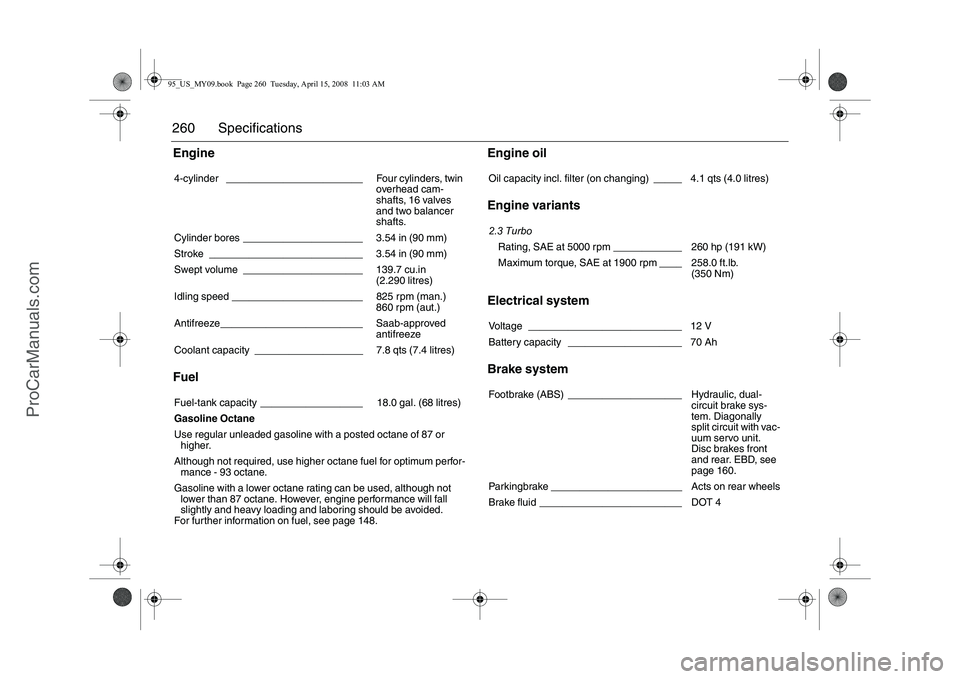
260 SpecificationsEngine Fuel Engine oil
Engine variants
Electrical system
Brake system
4-cylinder ________________________ Four cylinders, twin
overhead cam-
shafts, 16 valves
and two balancer
shafts.
Cylinder bores _____________________ 3.54 in (90 mm)
Stroke ___________________________ 3.54 in (90 mm)
Swept volume _____________________ 139.7 cu.in
(2.290 litres)
Idling speed _______________________ 825 rpm (man.)
860 rpm (aut.)
Antifreeze_________________________ Saab-approved
antifreeze
Coolant capacity ___________________ 7.8 qts (7.4 litres)
Fuel-tank capacity __________________ 18.0 gal. (68 litres)
Gasoline Octane
Use regular unleaded gasoline with a posted octane of 87 or
higher.
Although not required, use higher octane fuel for optimum perfor-
mance - 93 octane.
Gasoline with a lower octane rating can be used, although not
lower than 87 octane. However, engine performance will fall
slightly and heavy loading and laboring should be avoided.
For further information on fuel, see page 148.Oil capacity incl. filter (on changing) _____ 4.1 qts (4.0 litres)
2.3 Turbo
Rating, SAE at 5000 rpm ____________ 260 hp (191 kW)
Maximum torque, SAE at 1900 rpm ____ 258.0 ft.lb.
(350 Nm)
Voltage ___________________________ 12 V
Battery capacity ____________________ 70 Ah
Footbrake (ABS) ____________________ Hydraulic, dual-
circuit brake sys-
tem. Diagonally
split circuit with vac-
uum servo unit.
Disc brakes front
and rear. EBD, see
page 160.
Parkingbrake _______________________ Acts on rear wheels
Brake fluid _________________________ DOT 4 95_US_MY09.book Page 260 Tuesday, April 15, 2008 11:03 AM
ProCarManuals.com
Page 269 of 272

269 Index
Immobilizer
_____________________ 49
Indicator and warning lights
________ 58
Indicator lights
___________________ 58
Information about fuel
____________ 148
Instrument illumination ____________ 75
Instruments and controls ___________ 57
Interior equipment
_______________ 113
Interior lighting
_________________ 124
Interior rearview mirror
___________ 116
JJack
__________________________ 238
KKey
___________________________ 44
Key, remove
___________________ 140
LLATCH (child safety)
______________ 23
Labeling, tire sidewall ____________ 227
Labels
__________________________ 7
Leather upholstery, care of
________ 241
Light horn
______________________ 73
Light switches ___________________ 73
Loading MP3 discs
______________ 102
Loading your vehicle _____________ 229
Luggage-compartment lighting
_____ 125
MMP3 player
____________________ 102
Main instrument panel
_____________ 58
Main/dipped beam
________________ 73
Maintenance schedule
___________ 252
Maintenance, A/C-system _________ 244
Maxi fuses
_____________________ 215
Milometer ______________________ 64
Moonroof ______________________ 123
Motoring abroad
________________ 247
Multipath propagation
____________ 109
NNIGHT
_________________________ 72
New tires, buying
________________ 223
Night Panel
_____________________ 72
OOdometer
______________________ 64
Oil capacity, engine
______________ 260
Oil specification
_________________ 260
Outdoor temperature
______________ 68
Owner assistance
_______________ 253
PPaintwork, touching-in
____________ 243
Parcel shelf, folding
______________ 133Parking Assistance
______________ 168
Parking lights
____________________ 73
Plates and labels
________________ 264
Poly-V-belt
_____________________ 199
Portable fuel container
___________ 148
Portable player
_________________ 104
Power outlet
___________________ 126
Power steering _________________ 196
Power-steering fluid
______________ 196
Pressure gauge
__________________ 67
Prestige
_______________________ 107
Programme type ALARM
__________ 99
QQuality grading, tires
_____________ 224
Questions on function of airbag
______ 40
RRDS time
______________________ 106
Radiator fan ____________________ 199
Radio
__________________________ 93
Radio Data System (RDS)
_________ 94
Radio text
______________________ 94
Radio waves ___________________ 110
Rain sensor _____________________ 77
Random playback of MP3 files, CD
__ 103
Random playback, CD
____________ 99
Random playback, CD changer
____ 101
Rapid playing an MP3 file
_________ 103
95_US_MY09.book Page 269 Tuesday, April 15, 2008 11:03 AM
ProCarManuals.com